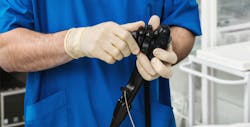Sterile Processing intersects cost, quality and outcomes
Mince no words: Sterile Processing is essential to assuring and ensuring high-quality healthcare delivery. In fact, one may argue successfully that the sterile processing function – and the valuable team members who make it happen on a daily basis – represent the cornerstone of surgical repair and patient care.
Physicians and surgeons may balk at that notion (nurses know better because plenty support and work in sterile processing areas) until they notice their devices, instruments and tools are not accessible or available to them.
Critics and pessimists will label that inefficiency; cynics and optimists alike will call that power. Think about it.
The sterile processing profession attracted quite a bit of consumer and trade media attention this past year, stemming from devices (e.g., duodenoscopes) found to have been improperly cleaned, high-level disinfected and sterilized that may have or most likely contributed to infectious outbreaks in surgical patients, ranging from sepsis to superbug. Much depends on your preferred burden of proof – reasonable or shadow of a doubt or just plain logical and scientific theory.
Because sterile processing professionals – from technologists up to directors – are so important to healthcare progress, Healthcare Purchasing News debuted its annual Endoscope Care Guide a dozen years ago to serve as a valuable source of information for process improvement. Moreover, recognizing sterile processing’s inherent value, HPN began covering the department and function since its inception 39 years ago. That will continue well into the next decade and beyond.
The Endoscope Care Guide strives to educate readers on costly, high-tech device maintenance in an easy-to-digest, entertaining and informative format. We created and developed this as a reader service to provide clinicians and administrators with useful information on cleaning, disinfecting, sterilizing, repairing, maintaining, storing and tracking all types of flexible and rigid endoscopes thoroughly, efficiently and cost-effectively. It’s designed to serve a dual purpose as a healthy reminder for experienced industry veterans and an introductory refresher for those growing their experience.
Historically, HPN’s exclusive guide highlights the obvious and overlooked dangers from improper cleaning, repair and storage, and identifies best practices for device longevity and reliability. HPN recruited experts and professionals from some of the leading companies that manufacture endoscopic products and offer endoscopic care services to share their expertise on making sure these costly surgical tools are ready for action all year long.
This year’s Endoscope Care Guide concentrates on three primary topics governing its attention, intent and output: Manufacturer instructions for use (IFUs), duodenoscope design and outlook and the fundamental issue of cleaning strategies and tactics before high-level disinfection and sterilization.
INSIDE THE GUIDE…
- Manufacturer IFUs can stray from validation
- Missing links in manufacturer instructions-for-use can lead to process kinksReprocessing blueprint to fight infection
- Exploring the science behind true sterility
- SPD faces myriad challenges to comply with IFUs
- Spotting warning signs about cleaning effectiveness
- In pursuit of the perfectly processed device
- Duodenoscopes submerged in hot water
- Tips, tricks for inspecting endoscope cleanliness
- Narrating the pathogenesis of a deep organ surgical infection
- Endoscope Product Spotlights
EXCLUSIVELY ONLINE…
About the Author
Rick Dana Barlow
Senior Editor
Rick Dana Barlow is Senior Editor for Healthcare Purchasing News, an Endeavor Business Media publication. He can be reached at [email protected].

